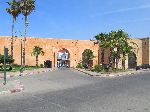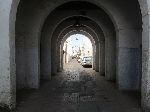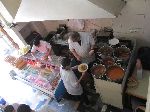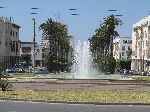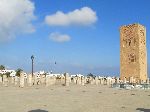|
Morocco:
West Atlas Bicycle Africa / Ibike Tours |
|||
 |
Atlantic Coast: Kenitra, Salé and Rabat | ||
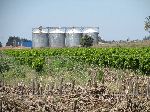 |
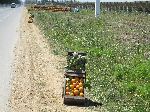 This section focuses on the central coast, starting north of Kenitra
and extending south to Casablanca. This section focuses on the central coast, starting north of Kenitra
and extending south to Casablanca.
The generally flat countryside is suitable for a variety of crops. Artichokes and oranges were available at the road side. Grain elevators suggest that wheat is grown in the area. There are a variety of orchards to be seen. The roadside selection of produce probably changes monthly, if not more often. |
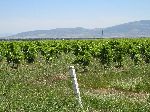 |
|
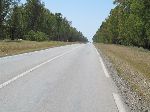 When the planes raise a little bit the farm land often gives way to eucalyptus
forest. Historically, this probably was all cork-oak forest that now has been replanted
with faster-growing eucalyptus. It also indicates how even a slight changes in topography and soil
condition can dramatically affect the lands usefulness for farming. When the planes raise a little bit the farm land often gives way to eucalyptus
forest. Historically, this probably was all cork-oak forest that now has been replanted
with faster-growing eucalyptus. It also indicates how even a slight changes in topography and soil
condition can dramatically affect the lands usefulness for farming. |
|||
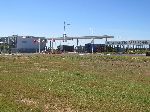 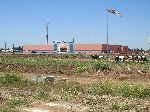 Even
with limited farmland, non-agriculture land use is pushing out agriculture.
Growing populations are expanding the urban footprint. Motorization is facilitating
superstores in cow grazing areas (left). And the desire for modern economic sector jobs
is replacing fruit orchard with light industrial "manufacturing orchards", like
the "Atlantic Free Zone" (right). Even
with limited farmland, non-agriculture land use is pushing out agriculture.
Growing populations are expanding the urban footprint. Motorization is facilitating
superstores in cow grazing areas (left). And the desire for modern economic sector jobs
is replacing fruit orchard with light industrial "manufacturing orchards", like
the "Atlantic Free Zone" (right). |
|||
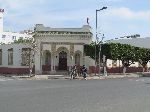 |
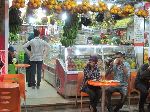  Kenitra
is probably rarely on the map for international tourists. There are some
nearby beaches that attract primarily Moroccans. An evening snapshot would make
it seem very much a modern family town: Children and parents stroll in the square,
young couples share a fresh fruit smoothie together along the main street and
McDonald's is full of families with young kids. Kenitra
is probably rarely on the map for international tourists. There are some
nearby beaches that attract primarily Moroccans. An evening snapshot would make
it seem very much a modern family town: Children and parents stroll in the square,
young couples share a fresh fruit smoothie together along the main street and
McDonald's is full of families with young kids. |
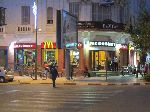 |
|
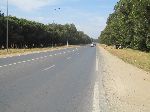 The Kenitra - Salé / Rabat road stays inland and parallels the coast
and behind the primary dune. The only
sign of the oceans are the signs to the various beaches along the way, one of
which was the Beach of Nations. The Kenitra - Salé / Rabat road stays inland and parallels the coast
and behind the primary dune. The only
sign of the oceans are the signs to the various beaches along the way, one of
which was the Beach of Nations. |
|||
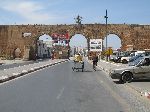 Parts
of Salé are still bounded by its old wall. It was
founded in 1030 and has a notorious history as being a haven for pirates. It was
incorporated into Morocco around the middle of the Alaouite Dynasty
(1666-1900). During the French Colonial period, it was a hotbed of activism
against colonial rule -- residing across the river in Rabat. It has long since
outgrown its wall and is beginning to sprawl. There
is certainly more to Salé, but this is what you see
from the highway. Parts
of Salé are still bounded by its old wall. It was
founded in 1030 and has a notorious history as being a haven for pirates. It was
incorporated into Morocco around the middle of the Alaouite Dynasty
(1666-1900). During the French Colonial period, it was a hotbed of activism
against colonial rule -- residing across the river in Rabat. It has long since
outgrown its wall and is beginning to sprawl. There
is certainly more to Salé, but this is what you see
from the highway. |
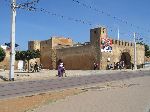 |
||
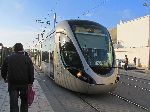 |
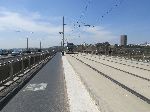  Salé
is in part a bedroom community for Rabat, separated by a river. As of May
2011, the two communities became conveniently connected a light rail system. The
new bridge for the tram also includes separate bike lanes and pedestrian path. Salé
is in part a bedroom community for Rabat, separated by a river. As of May
2011, the two communities became conveniently connected a light rail system. The
new bridge for the tram also includes separate bike lanes and pedestrian path. |
||
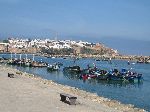 |
There have been settlements on the site of Rabat since ancient times. Its
long and rich history is reflected in monuments from the
Phoenician, Roman, Almohad and Merenid times. The center of governance and power shifted at times between
Rabat and Salé,
Rabat became a Muslim fortress in the 8th century. Almohad Sultan Yaqub's development initiatives left a physical legacy in the late 12th century. Later (17th and 18th century), it was a stronghold of corsairs - pirates named after their boats. In modern history, to avoid favoring either of the rival historical capitals of Fes and Marrakech, the French chose Rabat as the capital for the Protectorate of Morocco in the early 20th century. That status continued at Independence in 1956. Some of the locations in Rabat, with historical and cultural significance are: |
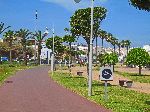
|
|
| Kasbah of the Udayas |
 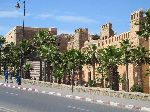 Kasbah of the
Oudaias (Udayas) was built during the reign of the Almohads (AD 1121-1269). When the Almohads captured Rabat
they destroyed the Kasbah of the Almoravids. The Almohads
began reconstructing it in AD 1150. They added a palace and a mosque
and named it al-Mahdiyya, after their ancestor al-Mahdi Ibn Tumart. After the
death of Sultan Yaqub al-Mansur (AD 1199), the Kasbah was deserted. Kasbah of the
Oudaias (Udayas) was built during the reign of the Almohads (AD 1121-1269). When the Almohads captured Rabat
they destroyed the Kasbah of the Almoravids. The Almohads
began reconstructing it in AD 1150. They added a palace and a mosque
and named it al-Mahdiyya, after their ancestor al-Mahdi Ibn Tumart. After the
death of Sultan Yaqub al-Mansur (AD 1199), the Kasbah was deserted. |
||
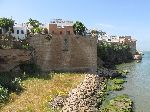
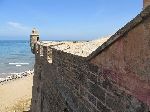
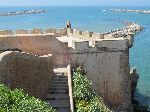
 |
|||
| The Kasbah's exterior (above) and interior (below) have a very different scale, color, texture, and details, but are about equal in their ability to slow you down, entertain the eye, and be photogenic subjects. It is particularly engaging to poke around the alleys of the interior. | |||
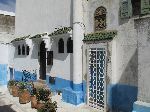

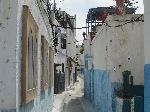
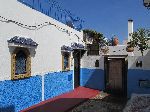 The interior of the Kasbah has now been revived as an artisan and upscale community, with the associated galleries and cliff-edge tourist amenities (café and restaurants). |
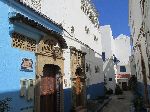 |
||
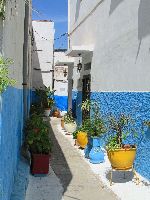 |
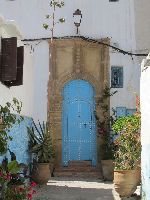
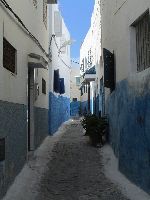
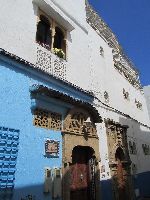
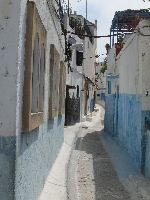 |
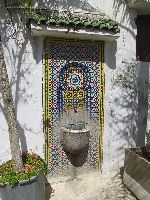 |
|
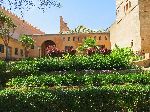 |
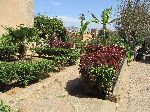 At
the south end of the complex is the Andalusian Gardens to unwind in. Many of
the house are whitewashed with light blue highlights. Combined with its narrow
streets, much of the interior has a clean, crisp
look, cozy feeling, similar to the feel and appearance of Sidi bou Said in Tunis
and village in the Greek Isles. At
the south end of the complex is the Andalusian Gardens to unwind in. Many of
the house are whitewashed with light blue highlights. Combined with its narrow
streets, much of the interior has a clean, crisp
look, cozy feeling, similar to the feel and appearance of Sidi bou Said in Tunis
and village in the Greek Isles. |
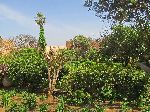 |
|
| Rabat Beach and Cimetière As-Shouhada' (Martyrs Cemetery) |
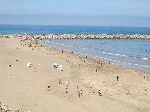 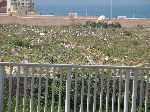 Below
the Kasbah, on both the Rabat and Salé sides
of the mouth of Bou Regreg River are beaches. They are predominantly used by
males. Upland from the Rabat Beach is the large
Cimetière As-Shouhada' (Martyrs Cemetery). Below
the Kasbah, on both the Rabat and Salé sides
of the mouth of Bou Regreg River are beaches. They are predominantly used by
males. Upland from the Rabat Beach is the large
Cimetière As-Shouhada' (Martyrs Cemetery). |
||
|
Rabat
Media
|
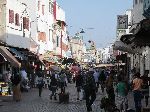
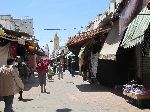
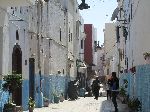
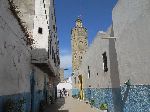
|
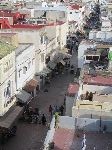 |
|
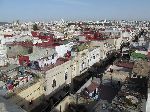 |
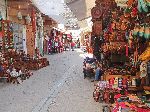
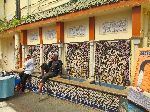
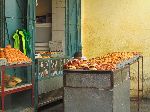
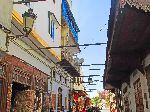 |
||
| Medina, Mellah |


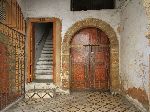
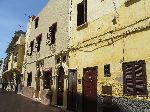 |
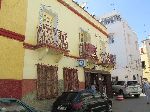 |
|
| Rabat's Mellah (Jewish Quarter) is tucked into the southeast corner of the medina. The are a few indicators that that it is the old Jewish Quarter: There are few entrances, the main alley is called Rue du Mellah, and one of the side streets is named Rue David Cohen (Rue Cheikh Daoud). An architectural feature that is common in Mellahs and virtually non-existent in Moslem quarters is residences with open balconies. | |||
| Medina: Fancy doors. |
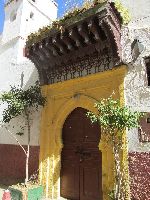
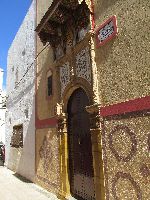
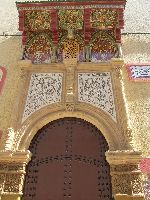
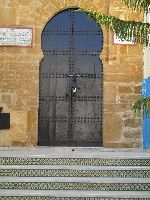 |
||
| Rabat, like most other North African medina's, has a number of ornate and beguiling entryways. Each new door is like finding another pearl on a walk. | |||
| Rabat New Town | Rabat's new town was conceived and built under the French Protectorate from 1912 to the 1930s, including royal and administrative areas, residential and commercial developments and the Jardins d’Essais botanical and pleasure gardens. Architecturally, it merges Art Deco, Andalusian, and Moorish elements. It also encompasses older parts of the city dating back to the 12thcentury. The new town is one of the largest and most ambitious modern urban projects built in Africa in the 20th century and probably the most complete. | ||
|
|
French District; Quartier Des Orangers and The atmosphere is as cosmopolitan as its economic big brother down the coast. Casablancans say that, with all the bureaucrats, Rabat is dull, but it is a weak point at best. The city is far less grimy and frantic than Casablanca and even a bit dressy. |
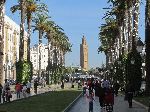 |
|
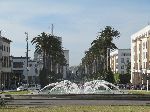
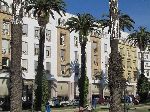

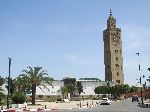 |
|||
| Along the boulevard and in the neighborhood nearby there are a number of prominent building: | |||
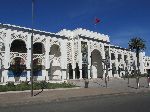
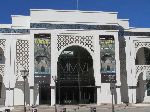
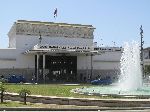 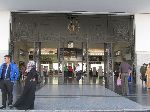 |
|||
| (above) Musée Mohamed VI d' Art Moderne et Contemporain (two left) and Gare Rabat Ville (two right; exterior and interior) | |||
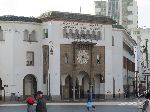
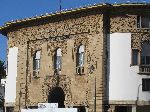
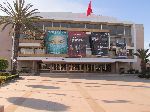
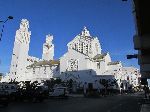 |
|||
| (above, from left to right) Rabat Post Office, Bank al Maghrib, Rabat Theatre, and Rabat Cathedral | |||
| Avenue Al Mansour Addahbe |
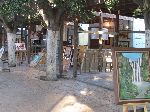 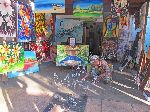  Along
Avenue Al Mansour Addahbe, there is an outdoor art market. Fourteen artists have
kiosks showing their work. Some have their studios on site and continue to work
as they wait for patrons. Along
Avenue Al Mansour Addahbe, there is an outdoor art market. Fourteen artists have
kiosks showing their work. Some have their studios on site and continue to work
as they wait for patrons. |
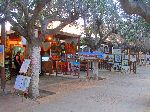 |
|
| Le Tour Hassan |
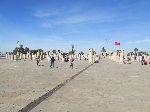  The
plaza of Le Tour Hassan (Tower of Hassan) could more easily be passed off as a
Roman inspired art installation than an 800-year-old Islamic ruin, The
explanation is, in fact, that Sultan Yacub al-Mansour (b.1160 - d.1199), the
third Caliph (r1184–99) of the Almohad Dynasty (~1120-1269), commission a mosque
and adjoining minaret, in 1195, that he intended to be the world's largest, in
its time. Much of the labor was done by Christian slaves that had been captured
in Iberia. With his untimely death of Yacub in 1199, construction on the mosque
stopped. The
plaza of Le Tour Hassan (Tower of Hassan) could more easily be passed off as a
Roman inspired art installation than an 800-year-old Islamic ruin, The
explanation is, in fact, that Sultan Yacub al-Mansour (b.1160 - d.1199), the
third Caliph (r1184–99) of the Almohad Dynasty (~1120-1269), commission a mosque
and adjoining minaret, in 1195, that he intended to be the world's largest, in
its time. Much of the labor was done by Christian slaves that had been captured
in Iberia. With his untimely death of Yacub in 1199, construction on the mosque
stopped. |
 |
|
| Mausolée Mohammed V |
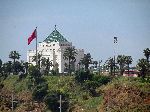 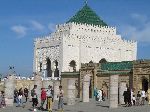 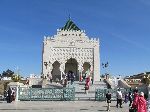 At
the south edge of Le Tour Hassan, looming above the Bou Regreg River is the
Mausolée Mohammed V. It contains the tombs of the Moroccan king and his two
sons, late King Hassan II, and Prince Abdallah. The building is considered a
masterpiece of modern Alaouite dynasty architecture, with its white silhouette,
topped by a typical green tiled roof, green being the color of Islam. A reader
of the Koran is often present, having his assigned seat. At
the south edge of Le Tour Hassan, looming above the Bou Regreg River is the
Mausolée Mohammed V. It contains the tombs of the Moroccan king and his two
sons, late King Hassan II, and Prince Abdallah. The building is considered a
masterpiece of modern Alaouite dynasty architecture, with its white silhouette,
topped by a typical green tiled roof, green being the color of Islam. A reader
of the Koran is often present, having his assigned seat. |
 |
|
| Challah |
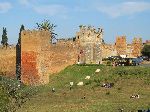 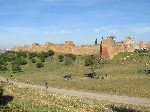 Challah
was the Roman port and commercial center of Sala Colonia. Sultan Yacub al-Mansour
also had a hand in the history of Chellah, when in the late 12th century he
converted the ghost town to a medieval, fortified necropolis. The site is now a
garden and tourist venue. It hosts an annual Jazz Festival. Challah
was the Roman port and commercial center of Sala Colonia. Sultan Yacub al-Mansour
also had a hand in the history of Chellah, when in the late 12th century he
converted the ghost town to a medieval, fortified necropolis. The site is now a
garden and tourist venue. It hosts an annual Jazz Festival. |
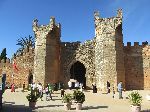 |
|
|
|
|||
|
|
|||
|
|
Unique Programs To Special Places For Memories Of A Lifetime!
"Hosted by
DreamHost - earth friendly web hosting"
|
|
